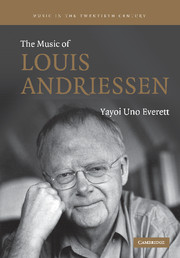Book contents
- Frontmatter
- Contents
- List of music examples and figures
- Acknowledgements
- List of abbreviations
- Introduction
- 1 Dutch music in the twentieth century
- 2 Formative years
- 3 Politics and “concept” works
- 4 Toward the metaphysical in art (1981–88)
- 5 Ramifications
- 6 Operatic collaboration with Peter Greenaway
- 7 Contemplative works
- 8 Epilogue
- Bibliography
- Index
1 - Dutch music in the twentieth century
Published online by Cambridge University Press: 22 September 2009
- Frontmatter
- Contents
- List of music examples and figures
- Acknowledgements
- List of abbreviations
- Introduction
- 1 Dutch music in the twentieth century
- 2 Formative years
- 3 Politics and “concept” works
- 4 Toward the metaphysical in art (1981–88)
- 5 Ramifications
- 6 Operatic collaboration with Peter Greenaway
- 7 Contemplative works
- 8 Epilogue
- Bibliography
- Index
Summary
The Hollander has always imported a substantial amount of wine, wheat, tobacco and music and considered this to be appropriate. He is not unwilling to consider that Dutch music can be as “good” as French or Austrian music, but he sure would like to get some validation first. The Dutch merchant will, if need be, make a purchase on a sample, rarely will he buy from a picture, and never based on an anonymous recommendation – Willem Pijper.
(Samama 1986: 13)In 1927, composer/critic Willem Pijper (1894–1947) expressed his disappointment over the general skepticism and indifference of the Dutch public toward their own music; in the quote above, he wonders where this “anti-musical disposition” came from and why Dutch musicians suffer from an overwhelming sense of cultural inferiority. Considering Holland's longstanding mercantile culture, Pijper speculated that an average countryman's valuation of music was dictated by an attitude that music is just another product to be measured against imported tobacco and wine. His reaction points to the sobriety (nuchterheid) of the Dutch bourgeoisie, people who steadfastly clung to familiar traditions and were not easily swayed by new and alluring trends. Simon Schama characterizes the provincial ideals of the Dutch in terms of: “bourgeois addiction to the prosaic, the literal, the frugal – the dispassionate objectification of the world and its reduction of mystery to commodity” (1987: 6).
- Type
- Chapter
- Information
- The Music of Louis Andriessen , pp. 12 - 28Publisher: Cambridge University PressPrint publication year: 2007

